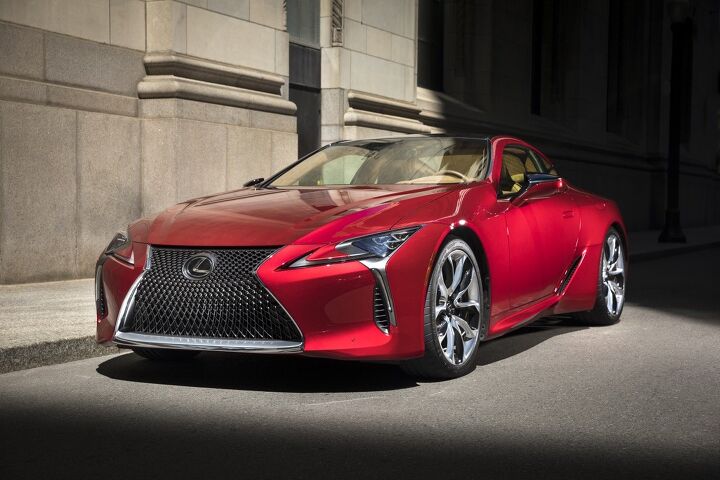You Thought Toyota's Lexus LC Sales Expectations Were Inconceivable … And You Were Right
Unless your surname is Porsche and your given name 911, the sales volumes generated by premium two-doors are frighteningly small. Lexus nevertheless brought to market the two-pronged Lexus LC range, as an indirect successor to the SC, with lofty expectations.
Moreover, Lexus was public with its goals, going so far as to respond directly to TTAC to defend the company’s reasoning.
If early figures were all we had to go by, the initial hype surrounding the $90K+, V8-engined LC500 and its hybrid LC500h sibling indisputably produced goal-besting results. More than a year into its tenure, however, it’s now clear that the LC has fallen wildly short of fulfilling Lexus’ hopes.
It was internal reactions, auto show response, and customer clinics that persuaded Lexus of the LC’s U.S. sales performance possibilities. “The first time I saw this car,” then Lexus division manager Mark Templin said of the LF-LC Concept in 2012, “I was speechless.”
“Our confidence started with the tremendous response to the LF-LC show car that debuted at the Detroit Auto Show in 2012,” Lexus communications manager Nancy Hubbell told TTAC last year. Then came a “dynamic clinic” in 2016 where Lexus heard feedback from customers that suggested “the LC will be a strong player in the luxury coupe market.”
The result was a 400 per month sales goal for the LC range. Lexus even stated its capacity to supply the United States with 500 LCs per month if demand was sufficient.
It wasn’t. It isn’t. It won’t be.
Just as the B&B predicted.
Comments on the early LC story included one from dal20402: “Setting a goal like this is just setting Lexus up for the unnecessary perception of failure.” badhobz said, “Dumb move. I don’t think it’ll do that well.” This was the general tenor of responses to Lexus, though there were some believers, and some, like stingray65, who thought Lexus could live up to its internal expectations for perhaps 4-6 months.
It turns out the LC was only capable of sustaining that high level of demand for two months. 419 were sold in May 2017. Then Lexus moved 423 in June of last year. A 402-unit month in July 2017 marked the end of Lexus hitting its target. Over the last 13 months, Lexus’ monthly average has fallen 48-percent shy of the 400-unit expectation. In the doldrums of winter, January and February combined for a paltry 304 total LC sales.
Granted, the Lexus LC is outselling the more costly Mercedes-AMG GT by more than 50 units per month and sells roughly as often as Mercedes-Benz’s SL-Class. The Lexus generates more than four times the volume of the aged and more performance-oriented Nissan GT-R.
On the other hand, with its vast 911 range, Porsche is on track for a three-year sales high of nearly 10,000 units, producing twice as many sales in an average month as Lexus did LC sales at the car’s peak.
That, of course, is an unfair comparison. Nothing competes with the 911. It’s in another league.
The Lexus LC, however, was supposed to compete with itself, and with the company’s own internal expectations.
No can do.
[Image: Lexus]
Timothy Cain is a contributing analyst at The Truth About Cars and Driving.ca and the founder and former editor of GoodCarBadCar.net. Follow on Twitter @timcaincars and Instagram.
More by Timothy Cain
Latest Car Reviews
Read moreLatest Product Reviews
Read moreRecent Comments
- ChristianWimmer Exterior and interior look pretty flawless for such a high mileage car. To me this is an indication that it was well-maintained and driven responsibly. It’s not my cup of tea but it’s bound to find an enthusiastic owner out there.And with ANY car, always budget for maintenance.
- Fred I'm a fan and watch every race. I've missed a few of the live races, but ESPN repeats them during more reasonable hours.
- Mikesixes It has potential benefits, but it has potential risks, too. It has inevitable costs, both in the price of the car and in future maintenance. Cars with ABS and airbags have cost me at least 2000 bucks in repairs, and have never saved me from any accidents. I'd rather these features were optional, and let the insurance companies figure out whether they do any good or not, and adjust their rates accordingly.
- Daniel Bridger Bidenomics working.
- Michael Gallagher Some math! The cost to produce US Shale derived oil is between $35 to $55/bbl. Middle East oil cost about $15/bbl. If OPEC wanted, they could produce more , driving oil prices below our costs and decimating our domestic industry. We have whispered in their ear that they should endeavor to keep the price above our cost, in exchange for political, economic and security favors. Case in point, during COVID when gas dropped below $2/gal , producers were losing money, Trump had to approach the Saudis requesting them to cut production to raise the oil price above our cost. If the global oil industry was truly competitive, our industry would be out of business very quickly due to our much higher cost of production. Those that long for those covid prices need to realize it would be at the expense of our domestic industry.


































Comments
Join the conversation
A quick google search reveals nine near new low mileage lc500‘s offered for under $80,000. Another one or two seem to appear each day.
My Lexus dealer keeps one in front. It's all they really need to do. The car looks even better in person. Bring your quarters there's an Aldi across the street.